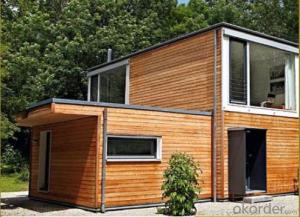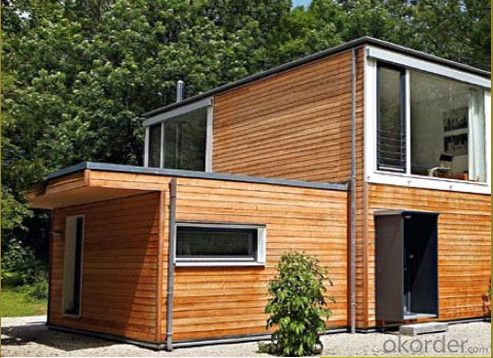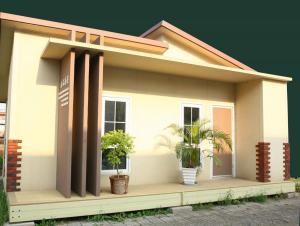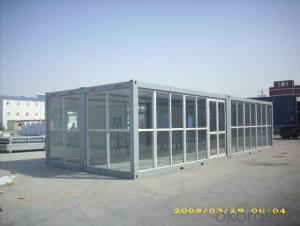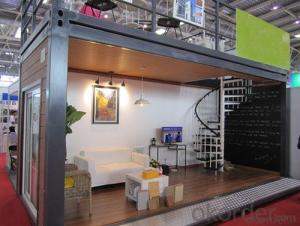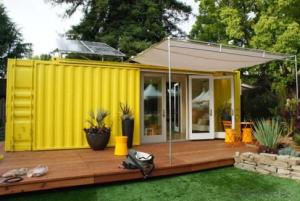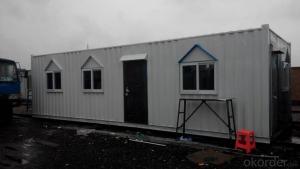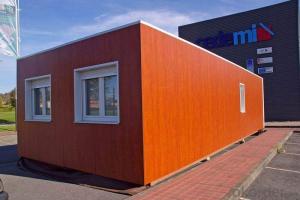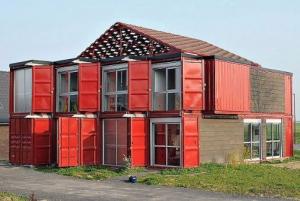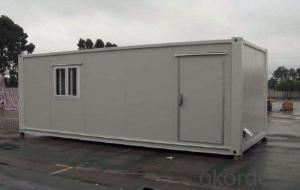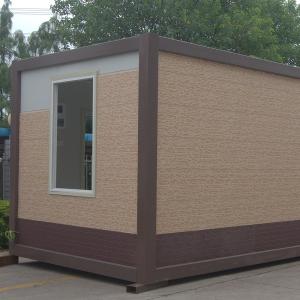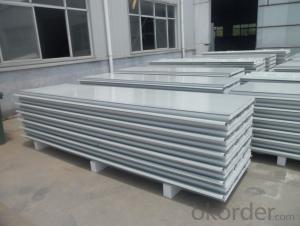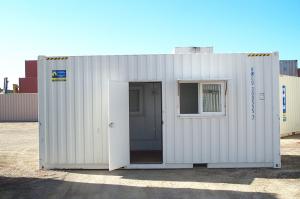Double luxury prefabricated container houses, are free to mix and match
OKorder Service Pledge
OKorder Financial Service
You Might Also Like
Specifications
1low cost modular house. low cost
2. easy installation
3 Green and environmental material
4. Power-Saved
Specifications
1. Firm structure and multiple use.
2. Lost cost and convenient in shippment.
CNBM INTERNATIONAL LOW COST PREBUILT CONTAINER HOUSES
Product description
1. Container house is a unit house with the size of 6055mm*2435mm*2740mm.
2. The container house adopts EPS, glass wool or rock wool as heat insulation material.
3. All the components are standard and prefabricated with the advantage of assembling and disassembling easily. Six skilled workers can finish three modular units in 8 hours.
4. 4sets of standard container house can be packed together to replace the shipping space of one 20ft container.
5. The container house can be linked freely at length, width and height through the linking kits for bigger structure and different layout.
6. Waterproof design of galvanized structure, fireproof and heat insulation of material ensure the house to resist heavy wind load of 0.6KN/m2and 8 degree seismic intensity.
7. The life span of the house is 20-25 years.
Characteristics
1. Cost Effectiveness
2. Chemical free, and lower waste
3. Easy to erect
4. Safety
5. Fireproof, termite free
6. Strong and durable – weatherproof, anti-seismic
7. Materials will not shrink, rot or warp
8. Pre-galvanized for rot and corrosion prevention
Benefits of factory built prefabricated houses and villas
| |
Very little maintenance | Reduce environmental pollution and save water |
Ease and speed of erection | Easily transportable |
Aesthetically pleasing | Buildings can be relocated |
Priced more economically than brick | Buildings can be designed by your choice
|
- Q: Are container houses resistant to earthquakes or seismic activity?
- Yes, container houses can be designed and built to be resistant to earthquakes or seismic activity. By reinforcing the structure and foundation, using flexible materials, and implementing proper engineering techniques, container houses can withstand seismic forces and minimize damage during earthquakes.
- Q: Can container houses be designed for adventure or outdoor tourism accommodations?
- Yes, container houses can be designed and modified to cater to adventure or outdoor tourism accommodations. The versatility and mobility of container houses make them ideal for creating unique and sustainable lodging options in remote or nature-filled locations. With proper insulation, ventilation, and additional amenities, container houses can provide comfortable and eco-friendly accommodations for outdoor enthusiasts seeking an adventurous experience.
- Q: Can container houses be designed with a green roof?
- Yes, container houses can be designed with a green roof. The modular nature of container houses allows for easy installation of green roof systems, which provide numerous environmental benefits such as improved insulation, reduced stormwater runoff, and enhanced biodiversity. Additionally, green roofs can help to mitigate urban heat island effect and improve air quality, making them a sustainable and attractive option for container house design.
- Q: Are container houses resistant to vandalism?
- Container houses can be resistant to vandalism as they are made of sturdy materials like steel that are difficult to break into. However, the level of resistance may vary depending on the specific design and security measures taken.
- Q: Are container houses suitable for Airbnb investment properties?
- Yes, container houses can be suitable for Airbnb investment properties. Container houses offer several advantages for Airbnb hosts, such as cost-effectiveness, sustainability, and unique design appeal. These structures can be easily customized and modified to create comfortable living spaces with all necessary amenities. Additionally, container houses can be transported and installed in various locations, providing flexibility for hosts to offer their properties in different areas. Overall, container houses can be a profitable investment for Airbnb properties due to their affordability and potential to attract guests seeking a distinctive and eco-friendly accommodation experience.
- Q: Are container houses suitable for small business owners?
- Yes, container houses can be suitable for small business owners for several reasons. Firstly, container houses are cost-effective compared to traditional brick and mortar structures. Small business owners often have limited budgets, and container houses provide an affordable option for setting up a business location. Secondly, container houses are highly versatile and customizable. They can be modified and tailored to meet the specific needs of different types of businesses. Whether it is a retail store, office space, or a small café, container houses can be adapted to create a functional and attractive workspace. Additionally, container houses are portable and can be easily relocated. This feature is particularly beneficial for small business owners who may need to change their location or expand their business in the future. Container houses can be easily transported to a new site, saving time and money on construction costs. Moreover, container houses are eco-friendly and sustainable. They are often made from recycled materials, reducing the environmental impact associated with traditional construction methods. Small business owners can align their business with sustainable practices by choosing a container house as their workspace. Overall, container houses provide a practical and affordable solution for small business owners. They offer versatility, cost-effectiveness, portability, and eco-friendliness, making them a suitable option for entrepreneurs with limited resources but big ambitions.
- Q: Are container houses suitable for senior living communities?
- Yes, container houses can be suitable for senior living communities. There are several reasons why container houses can be a viable option for senior living communities. Firstly, container houses are highly customizable and can be designed to meet the specific needs of senior citizens. They can easily be modified to include features such as wider doorways, ramps, and grab bars to ensure better accessibility for seniors with mobility issues. Additionally, the layout of container houses can be adapted to accommodate medical equipment such as wheelchairs and walkers. Secondly, container houses offer a cost-effective solution for senior living communities. They are often more affordable than traditional housing options, making them an attractive choice for seniors on a fixed income. The construction and maintenance costs of container houses are generally lower than those of conventional homes, making them a more financially sustainable option for senior living communities. Furthermore, container houses are environmentally friendly. As they are made from repurposed shipping containers, they contribute to reducing waste and have a smaller carbon footprint compared to traditional housing. This aligns with the growing trend of sustainable living, which is gaining popularity among seniors as well. In addition to these practical benefits, container houses can foster a sense of community among seniors. The compact nature of container houses allows for closer proximity between neighbors, promoting social interactions and a stronger support network. This is crucial for seniors who may be at risk of isolation or loneliness. However, it is important to note that the suitability of container houses for senior living communities may also depend on the specific needs and preferences of the seniors in question. Some seniors may prefer the familiarity and aesthetics of traditional housing, while others may have specific health or care requirements that container houses may not be able to meet. Therefore, it is essential to consider the individual needs and preferences of seniors before deciding whether container houses are suitable for a particular senior living community.
- Q: Are container houses suitable for year-round living?
- Indeed, year-round living can be suitable in container houses. These dwellings are constructed using shipping containers, known for their remarkable durability and ability to withstand harsh weather conditions. By implementing appropriate insulation and adjustments, container houses can offer comfortable living spaces all year long. One of the primary benefits of container houses for year-round living lies in their capacity to endure extreme temperatures. These structures can be insulated with materials like foam or spray foam insulation, which contribute to temperature regulation indoors. Moreover, the installation of double-glazed windows and efficient heating and cooling systems can further enhance the comfort of the living space. Container houses can also be designed to incorporate all the essential amenities required for year-round living. They can be equipped with plumbing, electricity, and HVAC systems, similar to traditional houses. Through adequate space planning and design, it is possible to include all essential areas, such as bedrooms, bathrooms, kitchens, and living areas, within the container house. Furthermore, container houses present eco-friendly and cost-effective options for year-round living. The utilization of repurposed shipping containers reduces waste and overall construction expenses. Additionally, these houses boast high customizability and can be designed to be energy-efficient, making use of renewable energy sources like solar panels. However, it is crucial to take certain factors into consideration when contemplating container houses for year-round living. Proper site selection and foundation preparation are vital to ensure stability and durability. Additionally, implementing adequate ventilation and moisture control measures is necessary to prevent potential issues related to condensation or mold growth. To conclude, container houses can indeed be suitable for year-round living. By employing proper insulation, design, and amenities, these houses can offer comfortable and sustainable living spaces throughout the year. Nevertheless, it is essential to address any potential challenges and ensure the application of proper construction techniques in order to render container houses a viable option for year-round living.
- Q: What are the common floor plans for container houses?
- There are several common floor plans for container houses that can be customized to meet different needs and preferences. One of the most popular floor plans is the single-container layout, where a single shipping container is used as the main living space. This layout typically includes an open living area, a kitchenette, a bathroom, and a sleeping area. Another common floor plan is the multi-container layout, where multiple containers are combined to create a larger living space. This layout allows for more flexibility in terms of design and can include multiple bedrooms, a full-sized kitchen, a spacious living area, and additional rooms such as a home office or a storage area. Additionally, there are also two-story container house floor plans, where containers are stacked vertically to maximize space. This layout can include multiple bedrooms, bathrooms, and living areas on different levels, providing a more traditional home feel. Some container house floor plans also incorporate outdoor living spaces, such as covered decks or rooftop gardens, to make the most of the available space and create a seamless indoor-outdoor living experience. Ultimately, the floor plans for container houses can vary greatly depending on individual preferences, budget, and the number of containers used. With the flexibility of container construction, the possibilities for designing a unique and functional home are virtually endless.
- Q: Can container houses be built with a security system?
- Absolutely! It is indeed possible to incorporate a security system into container houses. Similar to traditional houses, container houses offer a range of security features to guarantee the well-being and safety of residents. Firstly, container houses can be equipped with the same types of security systems found in conventional homes, including burglar alarms, motion sensors, and security cameras. These systems can be strategically installed at entry points like doors and windows to detect any unauthorized access or suspicious activity. Moreover, container houses can make use of smart home technology to heighten security measures. This entails employing smart locks that can be controlled remotely through a smartphone application, ensuring that only authorized individuals can gain entry. By integrating with a home security system, homeowners can receive alerts and notifications on their phones in the event of any security breaches. Furthermore, container houses can reinforce their security by implementing measures that are specific to their unique structure. For example, the robust steel walls of container houses act as a deterrent to potential intruders. Windows can be fortified with security films or bars, while doors can be equipped with robust locks and deadbolts. Ultimately, the level of security in a container house can be tailored to meet the specific requirements and preferences of the homeowner. Whether opting for basic security measures or advanced smart home security systems, container houses can be constructed to provide a secure and protected living environment.
Send your message to us
Double luxury prefabricated container houses, are free to mix and match
OKorder Service Pledge
OKorder Financial Service
Similar products
Hot products
Hot Searches
Related keywords
